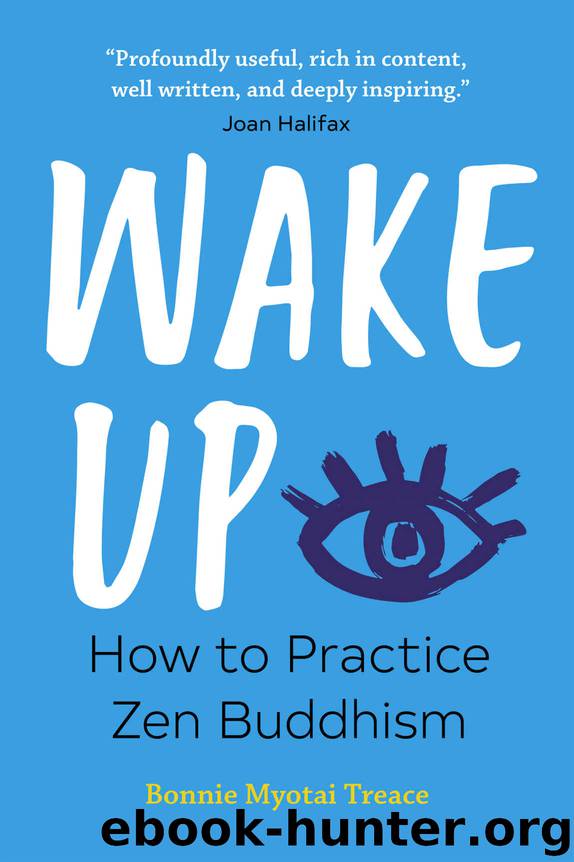Wake Up by Bonnie Myotai Treace

Author:Bonnie Myotai Treace [Treace, Bonnie Myotai]
Language: eng
Format: epub
ISBN: 9781641523905
Publisher: Rockridge Press
Published: 2019-10-08T04:00:00+00:00
Posture
Posture in zazen involves both the body and the mind. The lotus position (legs crossed onto opposite thighs) has been called the essence of zazen—in part because it is very stable and supportive, and perhaps also because the lotus thrives in a muddy pond, where otherwise stagnant waters blossom into astonishing, natural beauty. (My temple in NYC was called Fire Lotus to indicate that it was a place we’d use the fire and mud of daily life to fuel the flowering of spiritual life.) “No mud, no lotus,” Thich Nhat Hanh famously said.
But the implication of the lotus as a way of understanding zazen isn’t actually limited to those who, usually youngish and in the 20- to 40-year-old age range—or super-flexible yoga practitioners—can twist their legs into a pretzel shape. It is the radical stance of the mind and body in practice: Nothing is rejected; nothing better or other is needed.
The first key in seated Zen is to simply sit down; in other words, stop doing something else. Find a way of sitting that allows a sense of groundedness, stability, and comfort. This means: Establish a seated posture where you can be quite still for a good while without hurting yourself. Once you get settled, the practice does involve sitting still, essentially so we stop the internal habit of always “shopping” for some other position that is better than this. Most people find that, once they start that shopping, it is kind of endless: Adjust your foot, now your hip is out of line; move your hands a bit, suddenly your nose wants scratching . . . on and on. So, it’s not about being rigid, just settling in.
If you can sit on the floor, use a pillow to raise your behind off the ground 3 to 4 inches. This helps create the slight curve natural to the lower back. Fold your legs so that one isn’t pressing on top of the other, or else the bottom one will end up going to sleep as the minutes pass. Or sit on your knees using a bench or with a pillow between your legs. For a moment, elongate the spine a bit, and then relax, sway side to side a time or two, and you’ll have opened up your vertebrae and hips and released any tension hiding there.
If you’re better off in a chair, it’s best to sit upright without leaning back into it—that usually creates an unnatural curvature, and in short order, it begins to ache. Instead, trust your spine and internal organs to do what they are designed to do: support you. Keep your feet flat on the floor, or if you’re shorter, on a pillow that lets you keep your feet flat. For bedbound practitioners, try to arrange some pillows to keep you as upright and supported as possible. If you’re in a wheelchair, take a few moments to give attention to your posture and find your best alignment; placing a loosely rolled yoga mat vertically behind the spine can also be helpful.
Download
This site does not store any files on its server. We only index and link to content provided by other sites. Please contact the content providers to delete copyright contents if any and email us, we'll remove relevant links or contents immediately.
The Way of Zen by Alan W. Watts(6289)
Ego Is the Enemy by Ryan Holiday(4958)
The Art of Happiness by The Dalai Lama(3847)
The Book of Joy by Dalai Lama(3698)
Why Buddhism is True by Robert Wright(3284)
Spark Joy by Marie Kondo(3087)
Shift into Freedom by Loch Kelly(3029)
Happiness by Matthieu Ricard(2884)
A Monk's Guide to a Clean House and Mind by Shoukei Matsumoto(2783)
The Lost Art of Good Conversation by Sakyong Mipham(2438)
The Meaning of the Library by unknow(2385)
The Third Eye by T. Lobsang Rampa(2172)
The Unfettered Mind: Writings from a Zen Master to a Master Swordsman by Takuan Soho(2158)
Red Shambhala by Andrei Znamenski(2071)
Anthology by T J(2046)
The Diamond Cutter by Geshe Michael Roach(1955)
Thoughts Without A Thinker: Psychotherapy from a Buddhist Perspective by Epstein Mark(1893)
Advice Not Given by Mark Epstein(1763)
Twilight of Idols and Anti-Christ by Friedrich Nietzsche(1762)
